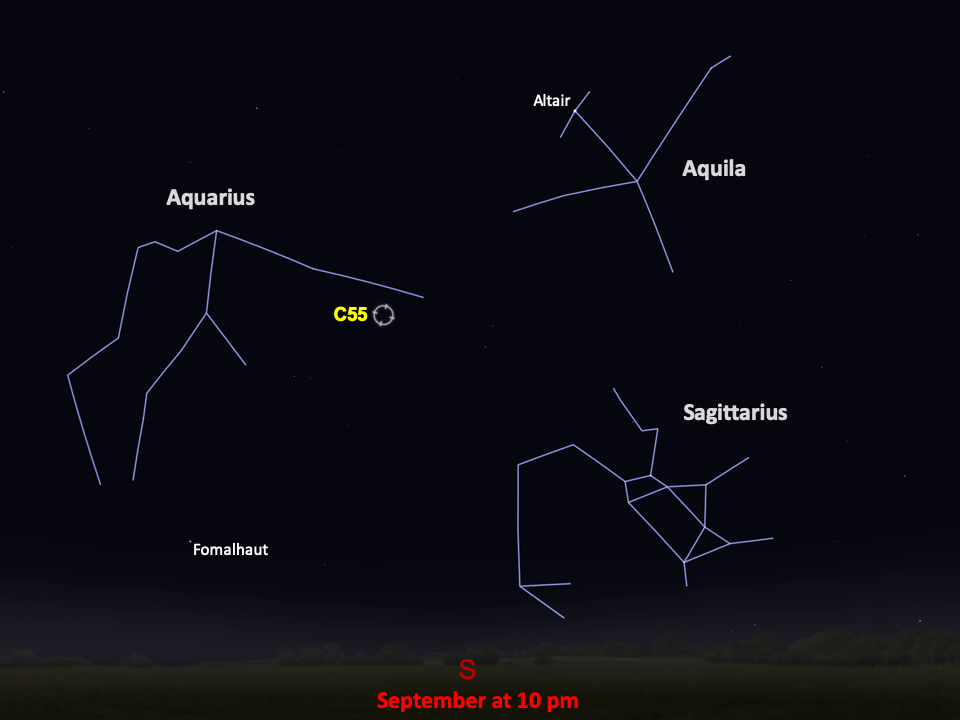Caldwell 55
Also known as the Saturn Nebula and NGC 7009, Caldwell 55 holds a dying star at its heart.
Distance
1,400 light-years
Apparent Magnitude
8.0
constellation
Aquarius
object type
Planetary Nebula

Garden-variety stars like the Sun live fairly placid lives in their galactic neighborhoods, steadily churning out heat and light for billions of years. When these stars reach retirement age, however, they transform into unique and often psychedelic works of art. This Hubble image of Caldwell 55, also known as the Saturn Nebula and NGC 7009, shows the result, called a planetary nebula. While it looks like a piece of wrapped cosmic candy, what we see is actually the outer gaseous layers of a dying star.
Stars are powered by nuclear fusion, but each one comes with a limited supply of fuel. When a medium-mass star exhausts its nuclear fuel, it will swell up and shrug off its outer layers until only a small, hot core remains. The leftover core, called a white dwarf, is a lot like a hot coal that glows after a barbecue — eventually it will fade out. Until then, the cast-off gaseous debris fluoresces as it expands out into the cosmos, possibly destined to be recycled into later generations of stars and planets.
The Saturn Nebula is only about 1,400 light-years away in the direction of the Aquarius constellation. Its proximity has made it a popular target for study by telescopes all around the world. Hubble took this image in visible light using the Wide Field and Planetary Camera 2 in 1996. Using Hubble’s observations, scientists have characterized the nebula's composition, structure, temperature, and the way it interacts with surrounding material. Studying planetary nebulae is particularly interesting since our Sun will experience a similar fate around five billion years down the road.
The Saturn Nebula has been known since 1782 when it was discovered by astronomer William Herschel. September skies will provide ideal viewing of this kaleidoscopic structure. This magnitude-8 nebula will look like a star in smaller telescopes, but larger telescopes will reveal more detail, including two extended lobes on either side of the nebula that resemble the rings of Saturn, lending the nebula its nickname. Using high magnification along with averted vision (looking away from the center of the object) will provide the best views of the fainter exterior regions of the nebula.
For more information about Hubble’s observations of Caldwell 55, see:
Planetary Nebula NGC 7009


Glossary
Magnitude - The brightness of an astronomical object, represented by a number; bright objects have low numbers on the magnitude scale, while dim objects have high numbers.
Nebula - An interstellar cloud of dust and gas; either a location where new stars are being forged or a cloud of material ejected into space by a dying star.
Planetary Nebula - An expanding shell of gas around an aging or dying Sun-like star, cast off by the star.
White Dwarf - The core of a dead Sun-like star whose outer layers have been expelled into space.
Explore Hubble's Caldwell Catalog
The following pages contain some of Hubble’s best images of Caldwell objects.

Caldwell 1
Also known as NGC 188, this group of stars formed from a large cloud of gas making the stars roughly…

Caldwell 2
This shell of gas is expanding outward, away from the dying star within.

Caldwell 3
This barred spiral galaxy was first spotted by British astronomer William Herschel in April 1793 in the constellation Draco.




